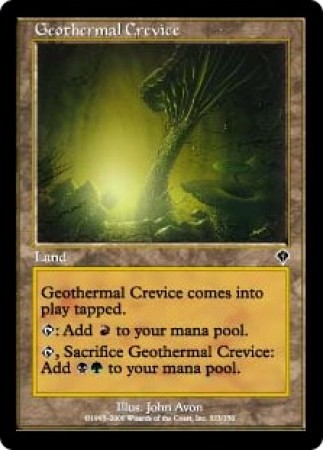18. Steam-Heated Caverns

18. Steam-Heated Caverns

|
|
|
|
|
|
|
|
|
|
|
|
Geography: This large
region of natural caverns was formed
by water erosion, but its
character has since been altered by
major subterranean upheavals.
Fiery volcanic action in nearby
sections of Deepearth created
sharp fissures throughout the
rock, and some of these
cracks in the world tapped into the
caverns .
The meandering river from
the Lower Lake reaches a cavern
about five miles south of
the main chambers of this area. This
connecting cavern is the
source of a rapid stream of relatively hot
water that joins the river.
The river, at this point, begins to pick up
speed as the the riverbed
starts to descend more steeply. A wide
shoreline coated with a
beach of fine sand provides an easy landing
for boat traffic.
The tunnel containing the
hot stream was originally part of the
area’s natural caverns,
but it has been artificially expanded to
handle an increased flow
of water. Its course has been straightened
and its rate of descent
increased, so that the hot water
races down a veritable chute
into the river.
The main area of caverns
contains six large caves that are connected
by several narrow passages.
The air is steamy and hot,
and water coats all rock
surfaces. Large pools of water fill the low
spots in many of the caverns.
Their temperatures range from boiling
hot to relatively cool.
Mildew on most of the rock surfaces
makes everything extremely
slippery.
A tunnel leading to the north
connects with Area 21. This natural
cavern is subject to blasts
of superheated air about once an
hour (2% chance per round,
cumulative; Le., 2% the first round
after a blast, 4% the next
round, 6% after that, etc.). Characters
in the tunnel at the time
sustain 4d6 points of damage, although
they can save vs. breath
weapon for half damage. Of course, normal
fire resistance benefits
might reduce this damage.
The tunnel leading to the
east is the source of the stream that
flows out of the area. As
the water flows through this area, however,
it becomes much hotter.
The entire cavern feels very hot,
and the water inflicts 4d6
points of damage per round, with saves
as above. If characters
are only partly immersed in the water,
reduce the damage accordingly.
Denizens: As might
be expected, this is a favorite haven for
creatures who love fire
and heat. In Area 21, the connection to the
Elemental Plane of Fire
has enabled creatures from that infernal
place to proliferate.
Efreet, fire elementals,
salamanders, and fire bats are all creatures
from the Plane of Fire that
can be encountered here. While
they may be hostile and
aggressive, they are far enough from
their escape routes that
they will not hesitate to flee an encounter
that is going badly.
Other creatures, including
hell hounds, giant rats, green slime,
carrion crawlers, and even
megalo centipedes, have made these
caverns their lairs, and
fight with normal tenacity.
The most formidable inhabitants
of the area are the fire giants,
who hold sway over all the
other denizens. Occasionally accompanied
by packs of hell hounds,
fire giants restlessly roam among
the large caverns, bullying
the lesser creatures and slaying any
who resist. Although they
claim the largest cavern as their lair, the
fire giants are basically
nomadic and may be encountered in any
part of this cave network.
When assembled, the clan of fire giants
numbers over 50 individuals.
Resources: The air
in these caverns is muggy && oppressive,
and characters unused to
the environment become fatigued in half
the usual time.
Water is plentiful, and
food in the form of
fungi is also abundant.
No mineral wealth has been located here.
Unique Features: Several
of the caverns in the area contain
geysers capable of spouting
of scalding water and steam every
bit as lethal as a red
dragon’s breath. A pool of water here is 20%
likely to be susceptible
to geyser activity. In addition, a number of
narrow cracks and niches
in the rock can issue such deadly
blasts. Characters caught
in the force of one of these geothermal
eruptions sustain 6d6 points
of damage, with saving throws vs.
breath weapon allowed to
reduce damage to 1/2. Fire resistant
benefits can further reduce
the damage.